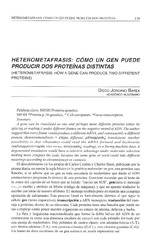Mostrar el registro sencillo del ítem
Heterometafrasis: cómo un gen puede producir dos proteínas distintas
| dc.contributor.author | Jordano-Barea, Diego | |
| dc.date.accessioned | 2012-04-03T08:53:34Z | |
| dc.date.available | 2012-04-03T08:53:34Z | |
| dc.date.issued | 1998 | |
| dc.identifier.uri | http://hdl.handle.net/10396/6742 | |
| dc.description.abstract | A gene can be translated as two and perhaps more different proteins either by splicing or reading it under different frames on the negative strand ofADN. The author suggest that everyframe would produce a different mRNA, and consequently a different protein, (heteterometafrasis = erepo, different; pirrotcppaon, translation). Another possibility is that ribosomes could read the mRNA forward and backwards (anfianagnosis=aimpt, vice versa; avoeyvo)on reading), as a Turing machine does. A degenerated translation would have a selective advantage under molecular selection making more compact the code, because the same gene or word could take different meanings according to circumstances or contexts. | es_ES |
| dc.format.mimetype | application/pdf | es_ES |
| dc.language.iso | spa | es_ES |
| dc.publisher | Real Academia de Córdoba, de Ciencias, Bellas Letras y Nobles Artes | es_ES |
| dc.rights | https://creativecommons.org/licenses/by-nc-nd/4.0/ | es_ES |
| dc.source | Boletín de la Real Academia de Córdoba 135, 139-142 (1998) | es_ES |
| dc.subject | MESH | es_ES |
| dc.subject | Proteins-genetics | es_ES |
| dc.subject | Cell computers | es_ES |
| dc.subject | Gene transcription | es_ES |
| dc.title | Heterometafrasis: cómo un gen puede producir dos proteínas distintas | es_ES |
| dc.type | info:eu-repo/semantics/article | es_ES |
| dc.rights.accessRights | info:eu-repo/semantics/openAccess | es_ES |

